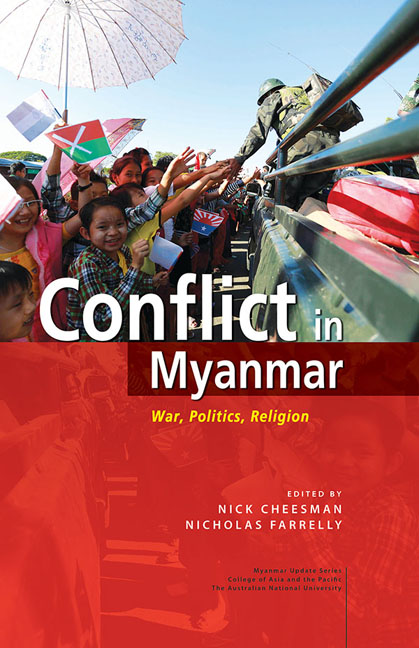Book contents
- Frontmatter
- Contents
- List of Maps
- List of Tables
- List of Figures
- Acknowledgements
- Contributors and Editors
- Part I Introduction
- Part II War and Order
- Part III Elections and After
- 7 The 2015 elections and conflict dynamics in Myanmar
- 8 Institutions in Myanmar's 2015 election: The election commission, international agencies, and the military
- 9 Ethnicity and Buddhist nationalism in the 2015 Rakhine State election results
- 10 The Hluttaw and conflicts in Myanmar
- 11 Legislating reform? Law and conflict in Myanmar
- Part IV Us and Them
- Part V Conclusion
- Abbreviations and Key Terms
- Index
11 - Legislating reform? Law and conflict in Myanmar
from Part III - Elections and After
Published online by Cambridge University Press: 22 July 2017
- Frontmatter
- Contents
- List of Maps
- List of Tables
- List of Figures
- Acknowledgements
- Contributors and Editors
- Part I Introduction
- Part II War and Order
- Part III Elections and After
- 7 The 2015 elections and conflict dynamics in Myanmar
- 8 Institutions in Myanmar's 2015 election: The election commission, international agencies, and the military
- 9 Ethnicity and Buddhist nationalism in the 2015 Rakhine State election results
- 10 The Hluttaw and conflicts in Myanmar
- 11 Legislating reform? Law and conflict in Myanmar
- Part IV Us and Them
- Part V Conclusion
- Abbreviations and Key Terms
- Index
Summary
What is the relationship between law and conflict? In particular, what role does law-making play in avoiding, managing, or exacerbating conflict? This chapter considers these issues in the context of Myanmar. Legal reform often occurs at moments of political conflict, crisis, and change, and this is also the case in Myanmar. Law reform may be undertaken for a range of reasons — to update, amend, or replace existing laws, to introduce a new policy, or to set a strategic direction in a particular area of reform.
Underneath these efforts at law reform in transitional contexts such as Myanmar there are often two implicit assumptions at play. First, it is sometimes assumed that law has not played an important role in Myanmar in the past. Second, it is assumed that in the post-2011 political transition era, law can and will make a more important contribution to the reform process. At the core of these assumptions is the idea that law helps, rather than hinders, conflict. I suggest that the relationship between law and conflict is more complex, and this is illustrated in the case of Myanmar.
Conflict in Myanmar is often referred to in the context of disputes over land, armed conflict between ethnic groups and the military, or violence directed against Muslims, as other chapters in this volume demonstrate (see in particular Chit Win, this volume). In this chapter, however, I examine conflict from a different angle by exploring the dual capacity of law as a tool to manage conflict, but also as an instrument that can be used to exacerbate conflict.
One way that law has been analysed in relation to conflict is in terms of the connection between law and violence. In his classic opening line, “Legal interpretation takes place in a field of pain and death”, Robert Cover (1995) focuses on the way violence is primarily evident in law through the process of interpretation. While the idea of interpretation is conceived in various ways due to the textual nature of law, this is often considered in terms of legal interpretation by the courts. The scholarship that has developed around Cover's work on law and violence includes focus on judicial interpretation and the role of judges, as well as its connection to criminal trials, practices of punishment, and torture (Cover 1995; Sarat and Kearns 1993; Sarat 2001).
- Type
- Chapter
- Information
- Conflict in MyanmarWar, Politics, Religion, pp. 221 - 242Publisher: ISEAS–Yusof Ishak InstitutePrint publication year: 2016

